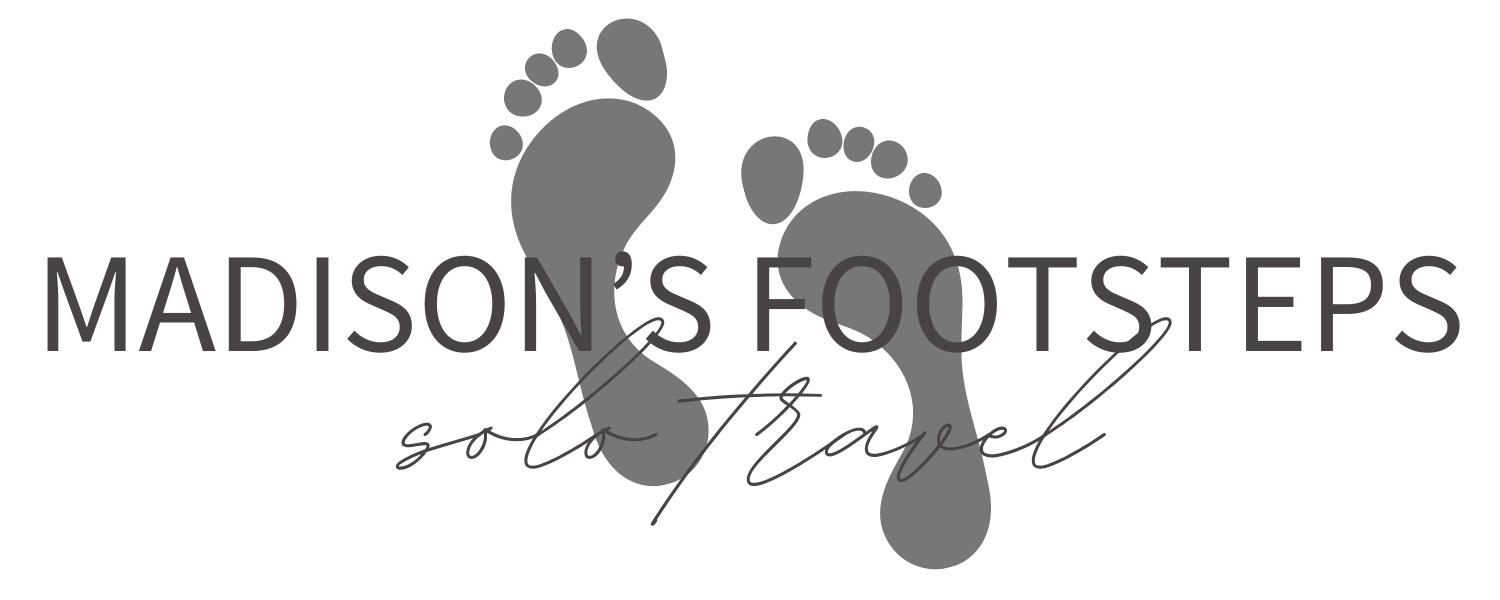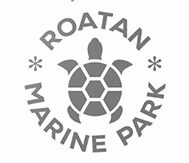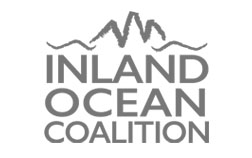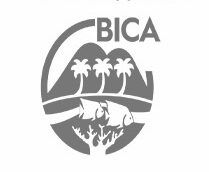Promoting Reef Safe Sunscreen in Roatan
Using truly reef safe sunscreen is one of the easiest ways to protect the reef in Roatan.
We’re lucky to dive the underwater treasure that is the Mesoamerican Reef in Roatan daily. Albeit, there are times when this daily connection with the reef can be tougher than you would expect. The familiarity we have with every swim through, uniquely shaped coral head or cleaning station also makes us acutely aware when these areas of the reef are suffering.
Climate change is the most detrimental man-made threat to our coral reefs – and here’s why.
But concentrations of harmful sunscreen ingredients add to the burden1. So, eliminating the use of non-reef safe sunscreen in Roatan is a simple action that everyone can take. This reduces the toxic load on our precious marine ecosystem. Furthermore, it’s a step we can all take to reduce toxic load on our own bodies.
That is why we are in support of the “Prove It’s Clean” movement and the petrochemical sunscreen ban in Roatan. And why we believe you should be too.
Read on to learn more about why using only reef safe sunscreen in Roatan matters. You’ll also learn how you can help pass the Petrochemical Sunscreen ban. Already a supporter of a petrochemical sunscreen ban in Roatan? Then sign this petition!
Learn More About Reef Safe Sunscreen in Roatan
Sunscreen Ingredients to Ban in Roatan
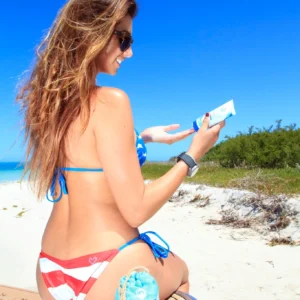
We are proposing a ban on these 6 sunscreen ingredients in Roatan. These ingredients are petrochemicals that are harmful to humans and the environment. This ban ensures that business and individual only sell and use mineral-based sunscreens in Roatan.
Here’s the list of toxic ingredient and why they are harmful according to the latest research:
- Oxybenzone (Benzophenone-3, BP-3) – disrupts coral reproduction, causes coral bleaching, and damages coral DNA.
- Octinoxate (Ethylhexyl methoxycinnamate) causes coral bleaching and toxic to seagrass.
- Octocrylene – causes metabolic distress in corals and deformity of developing fish larvae.
- Benzophenone (a breakdown product of Octocrylene) – known carcinogen, endocrine disruptor and a patented herbicide that induces coral bleaching and kill seagrass. Source:
- Homosalate – is a teratogen from sea urchin and fish to humans.
- Avobenzone – is toxic to algae, can cause coral to bleach, and can cause blindness in developing fish larvae.
Additionally, there are many other ingredients in sunscreens that experts advise consumers to avoid because they are either harmful to the environment or to human health. Read our blog on how to tell if your sunscreen is reef safe.
How Does a Non-Reef Safe Sunscreen Ban in Roatan Actually Work
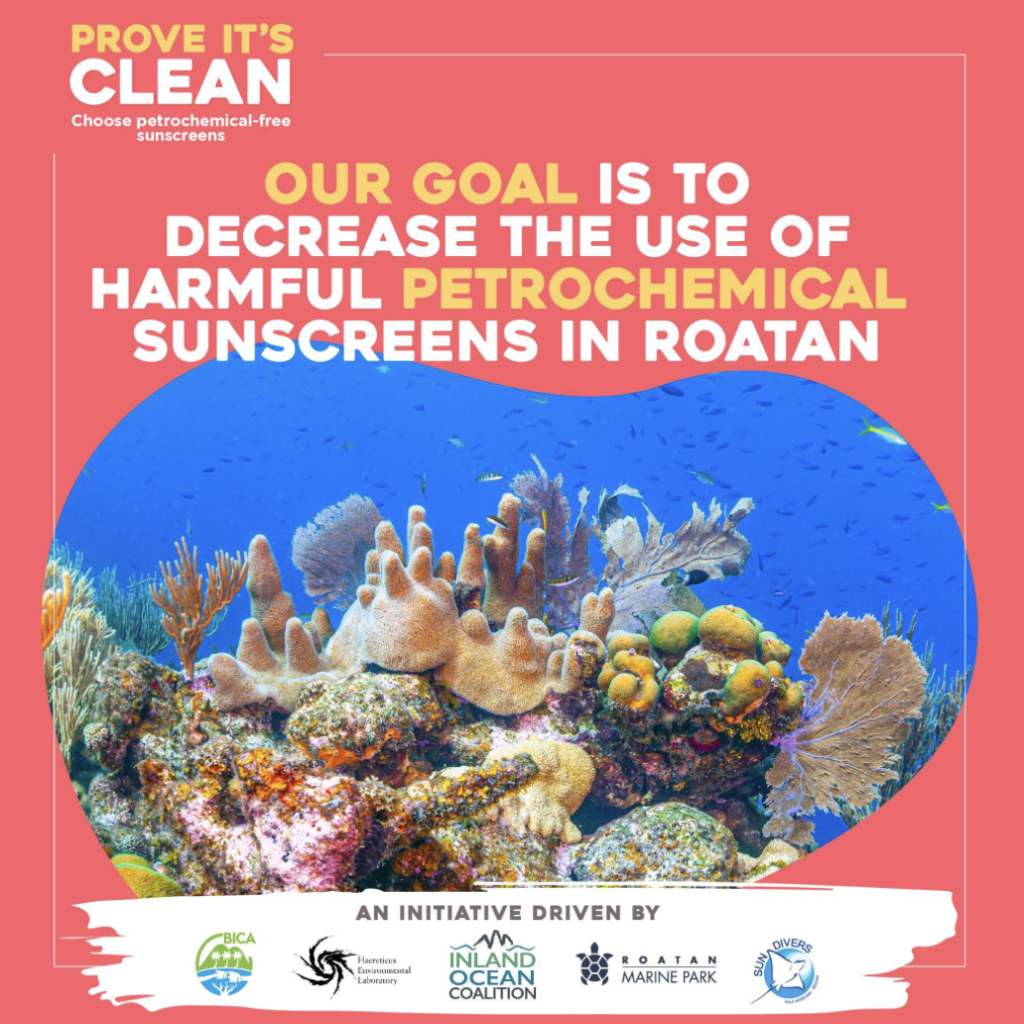
Getting municipal approval for a ban on non-reef safe sunscreens in Roatan is no easy feat. In fact, this is a labor of love over the past year by a number of local and international organizations. We have come together as the Eco-Friendly Sunscreen Coalition.
A lot of strategic work is happening behind the scenes. our first milestone is developing a formal petition to be presented to the Municipality of Roatan. We’re now gathering support for this petition through phsycial signatures from residents, online signatures from visitors and letters of support from local businesses. If you love Roatan, but don’t live here, you can sign the Change.or petition here. If you’re a local business on Roatan who wants to offer a letter of support, contact us and we can provide instructions.
When the petition is accepted by the municipality, the ban will then be put to a vote during Roatan’s election season in October 2024. The ban would not go into immediate effect as to give local businesses the opportunity to change what sunscreen products they procure for sale, but there would be a deadline.
Similar environmental laws have been enacted before on Roatan. Namely the single-use plastic ban of 2019 that came from the Last Straw campaign. While bans of this nature can be difficult to enforce, the Last Straw campaign showed that they can help make substantial change. It is hard to find a plastic straw in any restaurant in Roatan, plastic bags in grocery stores are just not a thing here. And many local restaurants are careful not to use styrofoam containers for take away.
How You Can Support the Petrochemical Sunscreen Ban in Roatan
If you believe it’s important that we ban non-reef safe sunscreens in Roatan, here’s what you can do:
- If you’re a local resident, stop by Sun Divers to sign the petition! We need all the signatures we can get from local residents.
- Sign the petition to ban petrochemical sunscreens
- Share the petition with your community including friends, family, colleagues and social media.
- If you own a business on Roatan, submit a letter of support
- Encourage the businesses that you buy from to support the ban
- Use only mineral-based sunscreens or, better yet, go sunscreen free and use UV protection clothing and hats to block the sun
The Folks Behind the Petrochemical Sunscreen Ban in Roatan
We want to give a huge shout out to the amazing individuals and organizations who we’ve been working with to spearhead this important endeavor. We encourage you to check out all the great work these organizations do. Visit their websites, follow them on social media and contribute to them.
Bay Island Conservation Association
Reef Safe Sunscreen FAQs
Where can I buy reef safe sunscreen in Roatan?
You can find truly reef safe sunscreen in select retail outlets, dive shops and resorts in Roatan including Sun Divers Roatan and the Roatan Marine Park EcoStore in West End. Unfortunately, at the moment most major supermarkets and mini markets only carry petrochemical sunscreen. Which is why we support the ban of non-reef safe sunscreen in Roatan.
What is a petrochemical?
Petrochemicals are the chemical products obtained from petroleum by refining (source Wikipedia). Many skin care products including sunscreen contain them. Petrochemicals can generate the known carcinogen 1,4-dioxane. In addition to being harmful to humans, they have catastrophic effects on coral and juvenile fish.
What makes sunscreen reef safe?
For a sunscreen to be truly reef safe it should be both non-toxic and biodegradable. While many sunscreen brands make these claims, there are certain brands that can back them up with testing & certifications. We’re fans of products that have the Protect Land & Sea certification.
Is mineral sunscreen reef safe?
Non-nano, mineral based sunscreens containing titanium dioxide or zinc oxide are consider to be the least harmful to coral reefs and marine life.
What sunscreen brands are reef safe?
Sunscreen brands that are non-nano, mineral based and biodegradable are considered to be reef safe. Brands that have been certified to be reef safe by the Protect Land & Sea certification include Stream2Sea, Badger and Tropic. The most important way to “prove it’s clean” is to look at the ingredient listing and make sure that your sunscreen does not contain any of the following ingredients: Oxybenzone, Octinoxate, Octocrylene, Benzophenone (a breakdown product of Octocrylene), Homosalate, and Avobenzone.
Where is sunscreen banned?
Certain sunscreens and ingredients are banned in 7 regions across globe: Hawaii, Key West, Fl., Palau, the U.S. Virgin Islands, Aruba, Bonaire and Mexico. Read more about the specific restrictions here.
1. Footnotes
Bordalo, D., Cuccaro, A., De Marchi, L., Soares, A. M. V. M., Meucci, V., Battaglia, F., Pretti, C., & Freitas, R. (2022). In vitro spermiotoxicity and in vivo adults’ biochemical pattern after exposure of the Mediterranean Mussel to the Sunscreen Avobenzone. Environmental Pollution, 312, 119987. https://doi.org/10.1016/j.envpol.2022.119987
Bordalo, D., Cuccaro, A., Meucci, V., De Marchi, L., Soares, A. M. V. M., Pretti, C., & Freitas, R. (2023). Will warmer summers increase the impact of UV filters on marine bivalves? Science of The Total Environment, 872, 162108. https://doi.org/10.1016/j.scitotenv.2023.162108
Boyd, A., Stewart, C. B., Philibert, D. A., How, Z. T., El-Din, M. G., Tierney, K. B., & Blewett, T. A. (2021). A burning issue: The effect of Organic Ultraviolet filter exposure on the behaviour and physiology of Daphnia Magna. Science of The Total Environment, 750, 141707. https://doi.org/10.1016/j.scitotenv.2020.141707
Christen, V., Zucchi, S., & Fent, K. (2011). Effects of the UV-filter 2-ethyl-hexyl-4-trimethoxycinnamate (EHMC) on expression of genes involved in hormonal pathways in fathead minnows (Pimephales promelas) and link to vitellogenin induction and histology. Aquatic Toxicology, 102(3–4), 167–176. https://doi.org/10.1016/j.aquatox.2011.01.013
Chu, S., Kwon, B. R., Lee, Y.-M., Zoh, K.-D., & Choi, K. (2021). Effects of 2-ethylhexyl-4-methoxycinnamate (EHMC) on thyroid hormones and genes associated with thyroid, neurotoxic, and nephrotoxic responses in adult and larval zebrafish (danio rerio). Chemosphere, 263, 128176. https://doi.org/10.1016/j.chemosphere.2020.128176
Dong, F., Zheng, M., Wang, H., Jing, C., He, J., Liu, S., Zhang, W., & Hu, F. (2022). Comparative transcriptome analysis reveals immunotoxicology induced by three organic UV filters in Manila clam (Ruditapes Philippinarum). Marine Pollution Bulletin, 185, 114313. https://doi.org/10.1016/j.marpolbul.2022.114313
Ebert, K. E., Griem, P., Weiss, T., Brüning, T., Hayen, H., Koch, H. M., & Bury, D. (2022). Diastereoselective metabolism of homomenthyl salicylate (homosalate): Identification of relevant human exposure biomarkers. Environment International, 170, 107637. https://doi.org/10.1016/j.envint.2022.107637
Fel, J.-P., Lacherez, C., Bensetra, A., Mezzache, S., Béraud, E., Léonard, M., Allemand, D., & Ferrier-Pagès, C. (2018). Photochemical response of the scleractinian coral stylophora pistillata to some sunscreen ingredients. Coral Reefs, 38(1), 109–122. https://doi.org/10.1007/s00338-018-01759-4
Inui, M., Adachi, T., Takenaka, S., Inui, H., Nakazawa, M., Ueda, M., Watanabe, H., Mori, C., Iguchi, T., & Miyatake, K. (2003). Effect of UV screens and preservatives on vitellogenin and choriogenin production in male medaka (oryzias latipes). Toxicology, 194(1–2), 43–50. https://doi.org/10.1016/s0300-483x(03)00340-8
Ka, Y., & Ji, K. (2022). Waterborne Exposure to Avobenzone and Octinoxate Induces Thyroid Endocrine Disruption in Wild-Type and Thrαa-/- Zebrafish Larvae. https://doi.org/10.21203/rs.3.rs-1242496/v1
Lee, I., Lee, J., Jung, D., Kim, S., & Choi, K. (2019). Two-generation exposure to 2-ethylhexyl 4-methoxycinnamate (EHMC) in Japanese medaka (oryzias latipes) and its reproduction and endocrine related effects. Chemosphere, 228, 478–484. https://doi.org/10.1016/j.chemosphere.2019.04.123
Liu, Y., Wang, Y., Li, N., & Jiang, S. (2022). Avobenzone and nanoplastics affect the development of zebrafish nervous system and retinal system and inhibit their locomotor behavior. Science of The Total Environment, 806, 150681. https://doi.org/10.1016/j.scitotenv.2021.150681
Lorigo, M., Quintaneiro, C., Breitenfeld, L., & Cairrao, E. (2021). UV-B filter octylmethoxycinnamate alters the vascular contractility patterns in pregnant women with hypothyroidism. Biomedicines, 9(2), 115. https://doi.org/10.3390/biomedicines9020115
Lozano, C., Givens, J., Stien, D., Matallana-Surget, S., & Lebaron, P. (2020). Bioaccumulation and toxicological effects of UV-filters on Marine Species. The Handbook of Environmental Chemistry, 85–130. https://doi.org/10.1007/698_2019_442
Ozáez, I., Morcillo, G., & Martínez-Guitarte, J.-L. (2016). Ultraviolet filters differentially impact the expression of key endocrine and stress genes in embryos and larvae of Chironomus riparius. Science of The Total Environment, 557–558, 240–247. https://doi.org/10.1016/j.scitotenv.2016.03.078
Schreurs, R. H. (2004). Interaction of polycyclic musks and UV filters with the estrogen receptor (ER), androgen receptor (AR), and progesterone receptor (PR) in reporter Gene bioassays. Toxicological Sciences, 83(2), 264–272. https://doi.org/10.1093/toxsci/kfi035
YAZAR, S., & GÖKÇEK, Y. (2018). Assessment of in vitro genotoxicity effect of homosalate in cosmetics. Journal of Research in Pharmacy, 22(1), 109–115. https://doi.org/10.12991/jrp.2018.84
Yazar, S., & Kara Ertekin, S. (2019). Assessment of the cytotoxicity and genotoxicity of Homosalate in MCF‐7. Journal of Cosmetic Dermatology, 19(1), 246–252. https://doi.org/10.1111/jocd.12973Zhou, R., Lu, G., Yan, Z., Bao, X., Zhang, P., & Jiang, R. (2019). Bioaccumulation and biochemical effects of ethylhexyl methoxy cinnamate and its main transformation products in Zebrafish. Aquatic Toxicology, 214, 105241. https://doi.org/10.1016/j.aquatox.2019.105241







